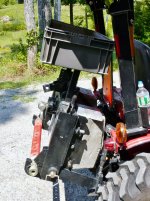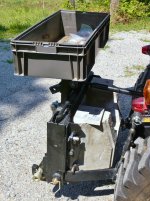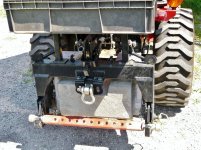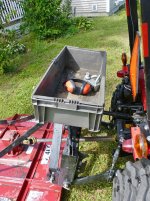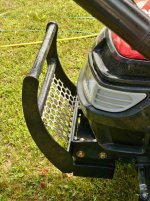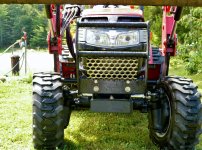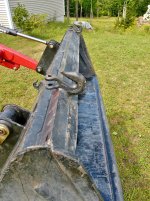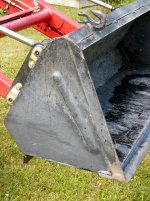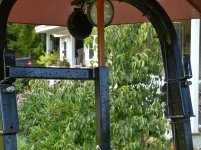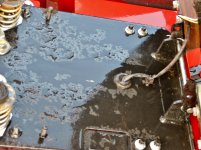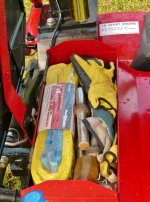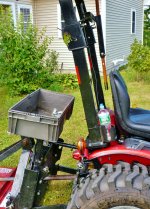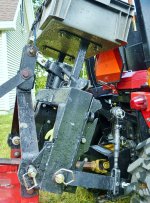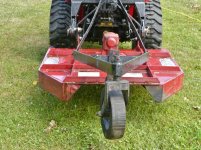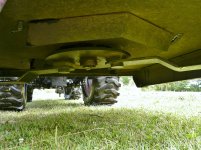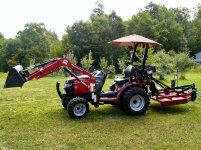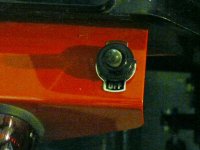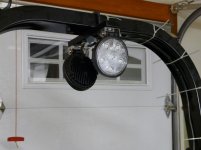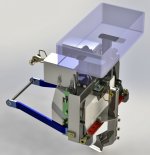mike69440
Elite Member
- Joined
- Jun 2, 2005
- Messages
- 3,266
- Location
- Central NH (God's Country)
- Tractor
- 2005 L39 Kubota, 2020 Polaris 570 Sportsman, 2006 RTV 900, 2019 RTV1100C, 1997 Komatsu PC75UU2E w/ Thumb & Blade, 2013 Mahindra Max28XL Shuttle plus many attachments
ITEM INFORMATION
Model year: 2013, Date Purchased: 12/11/2014 Number of Hours as 0f 8/15/15 :53 plus
My Max28 Shuttle now has +50 hrs of actual work on our farm, and its all dirty, like a tractor should be. The bucket paint is all not shiny smooth anymore.
I am been a mechanical engineer for 40 years, so excuse me if I'm a little harsh with my comments, for I have little tolerance for lack of design excellence.
I'm rather frugal, and the Max28 was thousands less than my tractor of choice, a large B Series Kubota. The Max28 Tractor specs extremely well against even larger tractors, I was looking for small. The Max28 is a largish small compact. Size wise it does fit in real well taking its place as the new small tractor on the farm.
My suggestions in this review are based of the MAX26 or 28 being designed toward a more suitable machine for a small strong Agricultural and light commercial Landscaping work, not as a light mowing/yard maintenance machine.
Here is my take on my 2013 Mahindra Max 28XL Shuttle with ML205 Loader.
What it is.
Versatile small CUT that than can be a 90 percent substitute from a SCUT up to a smaller Kubota L series tractor and the like. By making a few changes, a few changes it could cover 98% of the above.
With good loader lift capacity, and a bear of a Cat 1 3-point hitch, it can generally fight above its weight. Its smaller size and narrow width lets it fit in barn aisles. Turning radius is tight and it has a foldable ROPS bar.
Having the ability to accept mid mount attachments makes it a fair estate tractor but it is better suited to agricultural work.
It is a rather basic tractor that is reasonably well built.
However, the Loader control valve is a fail.
What is not.
Lacking a sturdy, stiff fame and having a light duty flexible loader. It is not suitable for extended landscape, construction or material handing. The weight of the tractor, requires about 500-700 lbs ballast for land engagement. It looses traction long before loosing power.
Neither is it a fancy estate tractor as it is both a little heavy and less refined than similar size light premium tractors.
My main beef with the tractor is the horrible to operate loader control valve. Other enhancements would be nice, but the loader control valve is the main downside.
Fix the Loader control valve and add some more substance to the frame and loader, plus a few other features would put this little tractor like no other in its class. There would be nothing else on the market that to a fair degree both cover the duties of both larger and smaller machines.
Mahindra only took this tractor so far, a little more and it would define a new class of Heavy Duty general purpose small nimble tractor.
Strong points, what I think Mitsubishi/Mahindra got right.
The 54 width fits thru a trimmed out nominal 5 barn door.
The turning radius is tight.
I like the 8x8 transmission. While not as nice as the GST of larger Kubota, or PST for that matter, the 8x8 forward and reverse with constant easy meshing gears, a separate reverser, and Hi-Low ranges is really nice to work as compared to a 6X2 gear typical of this size manual shift tractor.
The Loader has decent lift capacity. The loader curl strength is just ok for its size, but seems not a strong as the spec would indicate in the tougher going.
On the plus side, the loader will go into a soft sand pile and take a heaped full load out of the pile.
The relatively light base weight 2,500 Lb tractor/loader does not damage the front yard. We sort of have a lawn started.
The PTO is strong, lifting over a ton at he ball ends and 1,600 Lbs 24 back.
Power wise it seems about just right. Weight to HP ratio is way, way better that my heavy Kubota L39. 2nd or 3rd gear low range is a good speed for loader work, as you can quickly shift to 2nd or 3 rd high range for travel and dump. The Max 28XL shuttle does a fair grade in 4th gear high range on gravel roads. I did notice that the torque curve is narrower than my Kubota. Under about 1300-1400 RPM the Mahindra /Mitsubishi diesel torque drops (Lugging power is just not there!) off while the admittingly larger Kubota engine does not throw in the towel till 1000-1100 RPM.
Tractor build quality is decent, not as good as the best, but good. Most painted surfaces do not have a prime coat and is brittle, and as I understand, prone to fade. The exception is the brush guard that was a shame to grind off the nice paint to weld on a grill guard grate I fabricated.
The current weight of my Max28 is approx 2,650 Lbs without my 500 lb. counterweight. I have at least 40 Lbs of extra steel welded on the bucket, 90 Lbs of front ballast iron, and the 100 lb modified Quick Hitch on the rear. The tractor needs an extra 500lb. of removable weight for most of the work I use it for. I have designed and built a removable ballast weight designed to fit inboard of the Quick Hitch, and will post pictures of all my modifications in a separate post. On hills, ballast is needed for traction during ground engagement and for stability with a loaded bucket on uneven ground.
I'll break down my design critique into two areas:
#1.) Design improvement where a little thought, more than cost would make a big difference.
#2.) Adds to cost, but IMHO, be worth the benefit.
Under #1,
A.) The clutch engagement is abrupt however, making inching forward in tight areas difficult. Ever think how much an easy to modulate clutch, with a wide friction zone, al little marcel, would make detail work safer and more productive?
B.) The engine could be a lot quieter if some NHV effort was made. In its3elf the motor is fairly quiet, but there is a lot of sympathetic vibration and resonance in all the brackets, mounts and accessories.
C.) Make all common service components really easier to locate and access. The Max is not terrrible in this regard, except access to the dipstick
D.) Tether the fuel cap.
E.) Cup holders, Simply not planning in Cup Holders in the molded plastic parts on the fenders tells a lot.
Under #2
Even though doing so would increase the cost of the this tractor maybe 10 to 15%, these suggestions below for added features would make the Max the one of the best overall tractors regardless of size or price.
I think these features would really sell the tractor. Below are some features and fixes I would have paid more to have:
A.) The Loader control in really jerky and not very progressive. It borders on terrible. Surely no joy in this joystick. The float position detent will not hold the jigglily lever from popping out of float. The Loader control is like an economy 3rd world design than the nicer Kubotas I've been exposed to. The entire loader control s not the best integrated unit I've seen. If there is one reason not to consider this tractor it is the Loader valve.
B.) Structurally the ML205 Loader frame is quite flexi, and would be a lot more confidence inspiring if it were stiffer with more section modulus in the arms. It is very bouncy, especially with a load. I would not expect it to hold up well under heavy use. It is more suited for light farm work. I suspect that is why the tiny curl cylinders are furnished, as an offset load would bend the loader with bigger cylinders. Relatively speaking steel is cheap, and a little more wall thickness in the loader frame and tracor frame itself would go long way. I would not want to see what happens hitting an immoveable object hard. I don't know if the new curved beam style loader of the Max 26 is better than the old ML205.
C.) Larger 40 mm vs. the current 35 mm curl cylinders would help for better break out force.
D.) I reinforced the top and sides of the bucket and added a scraper to the bottom back for grading, as the bucket is typical of small tractors, i.e. flimsy in spots..
E.) The Loader seriously begs for a 4 Link linkage for articulation and more constant force through the range of bucket motion, such as the Kioti C2510. Option for a SSQA system at the bucket.
F.) Use a 56" wide bucket vs. a 54 and make bucket a bit taller, deeper and stronger. See K, L , M below.
G.) The tractor frame lacks torsional rigidity. The frame flexes in rough terrain such that the motor fan contacts the fan shroud.. A little more steel better placed could do a lot.
H.) The design of the 3Pt hitch lower links are such that they are not easily removed, as they are integrated into the Loader frame. An easy way to remove the lower hitch draw links should have been worked out.
I.) A with an option of a telescoping links would be nice.
J.) Add a real suspension seat on the base model. I have raised the front of the seat with 1-1/16" Spacers, and have added a spring suspension to the rear. Seat shape is not as comfortable or well built as a B Series Kubota. (Comfort sells, it makes that first impression)
.
K.) The plastics trim parts are average. I wonder how they will hold up to UV?
L.) 25x8.5-14 front tires in place of 23x8.5-12, for better flotation & traction.
M.) A bit more hydraulic pump capacity.
N.) Stronger power steering
O.) A 3 Speed HST or variable transmission non gear model.
P.) Accessory outlets and labeled wiring harness with extra tie in points in harness and fuse box.
Q.) A really good paint system with well bonded prime coat/ extra tough durable finish.
In all, ven considering the critique above this is a still good value in a small tractor. (At $16K or less) However If Mitsubishi/Mahindra wants the best tractor out there, start with enhancing the function of the loader control valve. I hope the latest MAX26 has addressed some of these issues. If not, Attn: Mahindra, I'd consider a consulting job.
Model year: 2013, Date Purchased: 12/11/2014 Number of Hours as 0f 8/15/15 :53 plus
My Max28 Shuttle now has +50 hrs of actual work on our farm, and its all dirty, like a tractor should be. The bucket paint is all not shiny smooth anymore.
I am been a mechanical engineer for 40 years, so excuse me if I'm a little harsh with my comments, for I have little tolerance for lack of design excellence.
I'm rather frugal, and the Max28 was thousands less than my tractor of choice, a large B Series Kubota. The Max28 Tractor specs extremely well against even larger tractors, I was looking for small. The Max28 is a largish small compact. Size wise it does fit in real well taking its place as the new small tractor on the farm.
My suggestions in this review are based of the MAX26 or 28 being designed toward a more suitable machine for a small strong Agricultural and light commercial Landscaping work, not as a light mowing/yard maintenance machine.
Here is my take on my 2013 Mahindra Max 28XL Shuttle with ML205 Loader.
What it is.
Versatile small CUT that than can be a 90 percent substitute from a SCUT up to a smaller Kubota L series tractor and the like. By making a few changes, a few changes it could cover 98% of the above.
With good loader lift capacity, and a bear of a Cat 1 3-point hitch, it can generally fight above its weight. Its smaller size and narrow width lets it fit in barn aisles. Turning radius is tight and it has a foldable ROPS bar.
Having the ability to accept mid mount attachments makes it a fair estate tractor but it is better suited to agricultural work.
It is a rather basic tractor that is reasonably well built.
However, the Loader control valve is a fail.
What is not.
Lacking a sturdy, stiff fame and having a light duty flexible loader. It is not suitable for extended landscape, construction or material handing. The weight of the tractor, requires about 500-700 lbs ballast for land engagement. It looses traction long before loosing power.
Neither is it a fancy estate tractor as it is both a little heavy and less refined than similar size light premium tractors.
My main beef with the tractor is the horrible to operate loader control valve. Other enhancements would be nice, but the loader control valve is the main downside.
Fix the Loader control valve and add some more substance to the frame and loader, plus a few other features would put this little tractor like no other in its class. There would be nothing else on the market that to a fair degree both cover the duties of both larger and smaller machines.
Mahindra only took this tractor so far, a little more and it would define a new class of Heavy Duty general purpose small nimble tractor.
Strong points, what I think Mitsubishi/Mahindra got right.
The 54 width fits thru a trimmed out nominal 5 barn door.
The turning radius is tight.
I like the 8x8 transmission. While not as nice as the GST of larger Kubota, or PST for that matter, the 8x8 forward and reverse with constant easy meshing gears, a separate reverser, and Hi-Low ranges is really nice to work as compared to a 6X2 gear typical of this size manual shift tractor.
The Loader has decent lift capacity. The loader curl strength is just ok for its size, but seems not a strong as the spec would indicate in the tougher going.
On the plus side, the loader will go into a soft sand pile and take a heaped full load out of the pile.
The relatively light base weight 2,500 Lb tractor/loader does not damage the front yard. We sort of have a lawn started.
The PTO is strong, lifting over a ton at he ball ends and 1,600 Lbs 24 back.
Power wise it seems about just right. Weight to HP ratio is way, way better that my heavy Kubota L39. 2nd or 3rd gear low range is a good speed for loader work, as you can quickly shift to 2nd or 3 rd high range for travel and dump. The Max 28XL shuttle does a fair grade in 4th gear high range on gravel roads. I did notice that the torque curve is narrower than my Kubota. Under about 1300-1400 RPM the Mahindra /Mitsubishi diesel torque drops (Lugging power is just not there!) off while the admittingly larger Kubota engine does not throw in the towel till 1000-1100 RPM.
Tractor build quality is decent, not as good as the best, but good. Most painted surfaces do not have a prime coat and is brittle, and as I understand, prone to fade. The exception is the brush guard that was a shame to grind off the nice paint to weld on a grill guard grate I fabricated.
The current weight of my Max28 is approx 2,650 Lbs without my 500 lb. counterweight. I have at least 40 Lbs of extra steel welded on the bucket, 90 Lbs of front ballast iron, and the 100 lb modified Quick Hitch on the rear. The tractor needs an extra 500lb. of removable weight for most of the work I use it for. I have designed and built a removable ballast weight designed to fit inboard of the Quick Hitch, and will post pictures of all my modifications in a separate post. On hills, ballast is needed for traction during ground engagement and for stability with a loaded bucket on uneven ground.
I'll break down my design critique into two areas:
#1.) Design improvement where a little thought, more than cost would make a big difference.
#2.) Adds to cost, but IMHO, be worth the benefit.
Under #1,
A.) The clutch engagement is abrupt however, making inching forward in tight areas difficult. Ever think how much an easy to modulate clutch, with a wide friction zone, al little marcel, would make detail work safer and more productive?
B.) The engine could be a lot quieter if some NHV effort was made. In its3elf the motor is fairly quiet, but there is a lot of sympathetic vibration and resonance in all the brackets, mounts and accessories.
C.) Make all common service components really easier to locate and access. The Max is not terrrible in this regard, except access to the dipstick
D.) Tether the fuel cap.
E.) Cup holders, Simply not planning in Cup Holders in the molded plastic parts on the fenders tells a lot.
Under #2
Even though doing so would increase the cost of the this tractor maybe 10 to 15%, these suggestions below for added features would make the Max the one of the best overall tractors regardless of size or price.
I think these features would really sell the tractor. Below are some features and fixes I would have paid more to have:
A.) The Loader control in really jerky and not very progressive. It borders on terrible. Surely no joy in this joystick. The float position detent will not hold the jigglily lever from popping out of float. The Loader control is like an economy 3rd world design than the nicer Kubotas I've been exposed to. The entire loader control s not the best integrated unit I've seen. If there is one reason not to consider this tractor it is the Loader valve.
B.) Structurally the ML205 Loader frame is quite flexi, and would be a lot more confidence inspiring if it were stiffer with more section modulus in the arms. It is very bouncy, especially with a load. I would not expect it to hold up well under heavy use. It is more suited for light farm work. I suspect that is why the tiny curl cylinders are furnished, as an offset load would bend the loader with bigger cylinders. Relatively speaking steel is cheap, and a little more wall thickness in the loader frame and tracor frame itself would go long way. I would not want to see what happens hitting an immoveable object hard. I don't know if the new curved beam style loader of the Max 26 is better than the old ML205.
C.) Larger 40 mm vs. the current 35 mm curl cylinders would help for better break out force.
D.) I reinforced the top and sides of the bucket and added a scraper to the bottom back for grading, as the bucket is typical of small tractors, i.e. flimsy in spots..
E.) The Loader seriously begs for a 4 Link linkage for articulation and more constant force through the range of bucket motion, such as the Kioti C2510. Option for a SSQA system at the bucket.
F.) Use a 56" wide bucket vs. a 54 and make bucket a bit taller, deeper and stronger. See K, L , M below.
G.) The tractor frame lacks torsional rigidity. The frame flexes in rough terrain such that the motor fan contacts the fan shroud.. A little more steel better placed could do a lot.
H.) The design of the 3Pt hitch lower links are such that they are not easily removed, as they are integrated into the Loader frame. An easy way to remove the lower hitch draw links should have been worked out.
I.) A with an option of a telescoping links would be nice.
J.) Add a real suspension seat on the base model. I have raised the front of the seat with 1-1/16" Spacers, and have added a spring suspension to the rear. Seat shape is not as comfortable or well built as a B Series Kubota. (Comfort sells, it makes that first impression)
.
K.) The plastics trim parts are average. I wonder how they will hold up to UV?
L.) 25x8.5-14 front tires in place of 23x8.5-12, for better flotation & traction.
M.) A bit more hydraulic pump capacity.
N.) Stronger power steering
O.) A 3 Speed HST or variable transmission non gear model.
P.) Accessory outlets and labeled wiring harness with extra tie in points in harness and fuse box.
Q.) A really good paint system with well bonded prime coat/ extra tough durable finish.
In all, ven considering the critique above this is a still good value in a small tractor. (At $16K or less) However If Mitsubishi/Mahindra wants the best tractor out there, start with enhancing the function of the loader control valve. I hope the latest MAX26 has addressed some of these issues. If not, Attn: Mahindra, I'd consider a consulting job.
Last edited:
